What to do if water doesn't go to the toilet: how to fix the
If in your bathroom water from a toilet bowl badly leaves, then it means that time has come to be engaged in a clearing of the sewerage. The most important thing here is not to panic. The work is not so difficult - everything is quite realistic to do independently and at the same time without any special financial costs.
In this article we will look at how you can quickly and effectively solve such a problem without having to call masters. After reading such information and advice, you will at least decide whether you will do something with your own hands or it will be easier to call plumbers.

To begin with, we will understand the causes of sewage blockages - as they say, knowing the reasons - it is easier to deal with the problem.
Causes of Congestion
Consider everything in the table below.
| Name of the reason: | More details: |
| Incorrect system operation | The matter in particular is that too much toilet paper or paper in general is being flushed down the drain. In addition, rags and various garbage are often sent to the highway. |
| Failure to comply with the installation conditions of the device and installation of the highway in particular | That is, an incorrect slope of pipes, an abundance of turns, as well as an elementary flushing of building mixtures during repair into the pipeline can “play” a cruel joke. |
| The design of the toilet. | Unfortunately, there are now a lot of products on the market, the design of the drain of which was not originally thought out. As a rule, this is mainly Chinese plumbing, the price of which is very low. Therefore, if you have such an appliance and constantly have problems with a sink, then the whole thing may be just that, and not the pollution of the main line. |
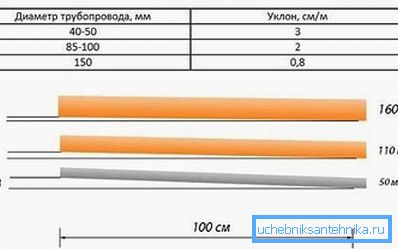
Note! In very cheap constructions another problem can occur - this is when the water leaves the toilet cistern. This means that the mechanism of the tank is made of low-quality elements that are usually even useless to repair. The best solution in this situation would be to replace the mechanism.
In principle, we familiarized ourselves with the reasons, now let's move on to solving the problem.
Ways to combat blockages
It should be noted that we will consider the most popular and proven technologies that can be implemented independently without any problems.
So, what to do if water goes badly in the toilet - a review of the first way to solve the problem.
Chemical method

The meaning of the solution lies in the fact that any chemical substances act on the blockage (usually alkali is present in their composition). The physics of the process is very simple - under the influence of chemistry, the “cork” begins to dissolve and after some time disappears completely.
Working with chemistry is effective in such cases:
- If pipes or drainage channel are clogged with paper or pieces of cloth.
- If the blockage consists of hair or food residue.
Instructions for the treatment of chemistry in almost all cases are approximately as follows:
- Open the package or bottle with the substance. It is very desirable to adhere to safety precautions and work in gloves and in a respirator.
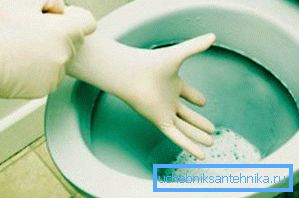
- Fill or fall asleep chemistry in the toilet.
- We close the lid of the toilet and leave the room for a while. The time of "work" of a substance can be different - from 15 minutes to several hours, read the rules for using the product on the label.
- After the required time has elapsed, open the lid and wash off the chemistry.. If you can see that there is an effect, but still the cork has not completely dissolved - you can repeat the operation.
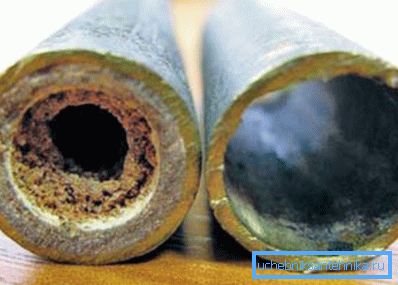
Tip: before starting such work, make sure that the tank mechanism is intact. After all, if the water spontaneously leaves the toilet, all the chemistry will simply flow out, as they say - into the pipe and will not have any effect on the blockage.
In addition, consider one more thing. If pipes are cast iron or plastic, then the alkali will not damage them, but the steel pipes may start to deteriorate if they are often in contact with such chemistry. So try not to clog the toilet, then not to wonder why the toilet does not leave the toilet and do not do too much work.
Further.
Mechanical method
This method can be performed primitively - with the help of an ordinary plunger, or a plumbing cable can be used.
The plunger, it turns out, creates pressure, under the influence of which the garbage either “moves off” and goes down the drain, or it pops up in the toilet and is then removed.
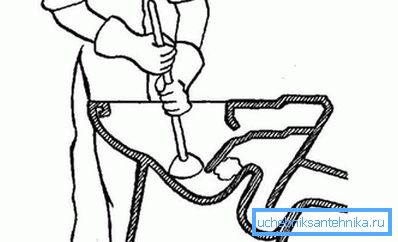
But the plumbing cable operates on a different principle - one end of the cable is launched into the drain hole and pushed into the main line until the metal rests on the plug. As soon as this happened, you need to start to rotate the wire around its axis. The point is that the end of the cable is screwed inside the cork and begins to destroy it during subsequent rotations.
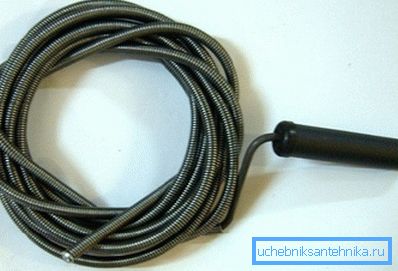
At the same time, one should constantly try to move the device back and forth in order to produce the maximum destruction of the problem point.
By the way, if the question is, why does the water go badly in the toilet, then the congestion is often “not” in the product, but in the main. That's just in this case, and it is important to apply the cable.

You can also successfully combine the chemical method and work with the cable - after contact with alkali the blockage becomes less durable and it is easier to mechanically act on it.
And one more technology.
Hydraulic way
If there is no water left in the toilet even after applying the two methods described above, then only two solutions remain - dismantle the main line, or try to act on the cork with a hydraulic shock.
The simplest scheme by which everything can be done on its own:
- Take enough flexible hose.
- Put one end on the tap.
- You push the second one into the drain hole of the toilet bowl and push it as close as possible to the traffic jam.
- Turn on hot water at full capacity.
In theory, if the water pressure in the system is good, then there is a chance to destroy the blockage.

Just be prepared for the fact that with this approach it is very easy to splash if the pressure of the water rests on the cork and as it would come back. But if the problem is not solved, either dismantle the pipes or call plumbers.
Conclusion
We figured out why the water slowly leaves the toilet and how to deal with this problem. We hope that the provided ways to resolve the issue will be useful to you in business, and you will be able to adjust the “work” of the bathroom.
If you want to see clearly how all this is done, then watch the video in this article, which is published above.